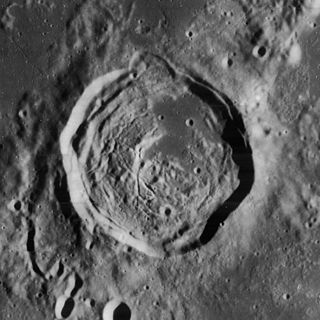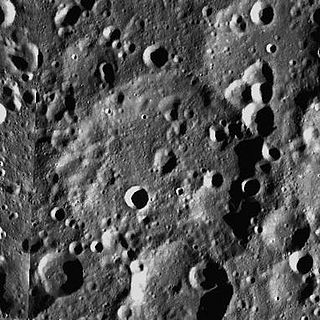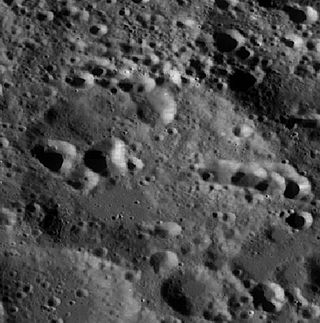
Cleomedes is a prominent lunar impact crater located in the northeast part of the visible Moon, to the north of Mare Crisium. It was named after Greek astronomer Cleomedes. It is surrounded by rough ground with multiple crater impacts. The irregular crater Tralles intrudes into the northwest rim. To the east is Delmotte. North of Cleomedes is a triple-crater formation with Burckhardt occupying the center.

Cavendish is a lunar impact crater that is located in the southwest part of the Moon, to the southwest of the larger crater Mersenius. It lies between the smaller craters Henry to the west-northwest and de Gasparis to the east-southeast.

Goclenius is a lunar impact crater that is located near the west edge of Mare Fecunditatis. It lies to the southeast of the lava-flooded crater Gutenberg, and north of Magelhaens. To the northwest is a parallel rille system that follow a course toward the northwest, running for a length of up to 240 kilometers. This feature is named the Rimae Goclenius.

Hansteen is a lunar impact crater that lies near the southwest edge of the Oceanus Procellarum. To the southeast is the flooded crater Billy. The rim of Hansteen is somewhat polygonal in form, especially along the eastern side. There are a few terraces along the northwestern inner wall. The inner floor contains several ridges, hills, and some grooves, many of which parallel the outer rim. There is a flat patch of lower-albedo material in the northeast part of the interior.

Joliot is a large lunar impact crater that lies on the far side of the Moon, just past the eastern limb. At this location it lies in a region of the surface that comes into sight during a favorable libration, although at such times it is viewed from the side. Thus viewing this crater in detail must be done from orbit.

Calippus is a small lunar impact crater that is located on the eastern edge of the rugged Montes Caucasus mountain range in the northern part of the Moon. It was named after Greek astronomer Callippus of Cyzicus. It lies to the southwest of the crater remnant Alexander, to the northwest of the Mare Serenitatis.

Belʹkovich is a large lunar impact crater of the form termed a walled plain. The formation has been heavily eroded by a history of subsequent impacts, leaving it reshaped, worn, and the features softened and rounded. Belʹkovich is located along the northeastern limb of the Moon, and so its visibility is subject to libration effects. From the Earth this crater is viewed from the side, making it difficult to view it in detail.

Barringer is a lunar impact crater that is located on the southern hemisphere on the Far side of the Moon, named after geologist Daniel Barringer. It is attached to the north-northeastern rim of the walled basin named Apollo, and lies to the southeast of Plummer. South of Barringer, on the floor of the Apollo basin, is the crater Scobee.

Barbier is a lunar impact crater that is located on the southern hemisphere on the far side of the Moon. It forms a matched pair with Cyrano to the north-northwest, and it lies to the southeast of the huge walled plain Gagarin. Southwest of Barbier is the crater Sierpinski, and to the southeast is the Mare Ingenii.

Darwin is a lunar impact crater of the type categorised as a walled plain. It lies in the southeastern part of the Moon, and is sufficiently close to the limb to appear significantly foreshortened when viewed from the Earth. Attached to its southern rim is Lamarck. To the northeast is the dark-floored crater Crüger.

De Forest is a lunar impact crater on the far side of the Moon. It is located in the far southern hemisphere, to the west of the large walled plain Zeeman and due south of the crater Numerov. Because of its proximity to the southern pole, this crater receives sunlight at an oblique angle when it is on the illuminated half of the Moon.

Catalán is a small lunar impact crater that lies almost along the southwest limb of the Moon. At this position the crater is ill-suited for observation from the Earth as it is viewed almost from the side, and visibility is subject to libration effects. It lies to the west of the somewhat larger crater Baade, and south-southeast of Graff. This region is located in the outer southeastern part of the skirt of ejecta that surrounds the Mare Orientale impact basin, and the nearby surface is rugged and streaky. This crater is named after the Spanish scientist Miguel Antonio Catalán Sañudo (1894–1957) for his contributions to spectroscopy, an important exploratory tool in astronomy.

Chebyshev is a large lunar impact crater that lies in the southern hemisphere on the far side of the Moon. The somewhat smaller crater Langmuir is intruding into the east-southeastern rim of Chebyshev, forming a chain of large craters with Brouwer on Langmuir's eastern rim.

d'Alembert is a large lunar impact crater located in the northern hemisphere on the far side of the Moon, to the northeast of the somewhat smaller walled plain Campbell. Astride the southwest rim of d'Alembert is Slipher. To the north is the crater Yamamoto, and to the south-southwest lies Langevin. This walled plain has the same diameter as Clavius on the near side, making it one of the largest such formations on the Moon.

Carnot is a large crater in the northern part of the Moon's far side. It was named after Nicolas L. S. Carnot by the IAU in 1970.

Chappell is a lunar impact crater on the far side of the Moon, in the northern hemisphere just to the north of the crater Debye. It is in a heavily bombarded section of the surface, and much of its outer rim is overlain by smaller craters. The northern rim in particular has been almost completely disintegrated, while small craters also overlie the rim to the northwest and southeast. What remains of the rim forms a rounded, somewhat irregular edge to the crater depression.

Debye is a lunar impact crater that is located in the northern hemisphere on the Moon's far side, as seen from the Earth. It lies to the south of the crater Chappell, to the southwest of the walled plain Rowland, and to the east of D'Alembert.

Chandler is a lunar impact crater in the northern hemisphere, on the Moon's far side. It lies to the southeast of the large walled plain D'Alembert, and southeast of the slightly smaller Chernyshev crater.

Comrie is a lunar impact crater. It is located on the rugged far side of the Moon relative to the Earth, beyond the western limb. Nearby craters of note include Ohm to the south-southwest, Shternberg to the southwest, and Parenago to the northeast.

Evershed is a lunar impact crater on the far side of the Moon, named after the English solar astronomer John Evershed. It is located to the northeast of the larger crater Cockcroft, and to the north of the smaller Van den Bergh.






















